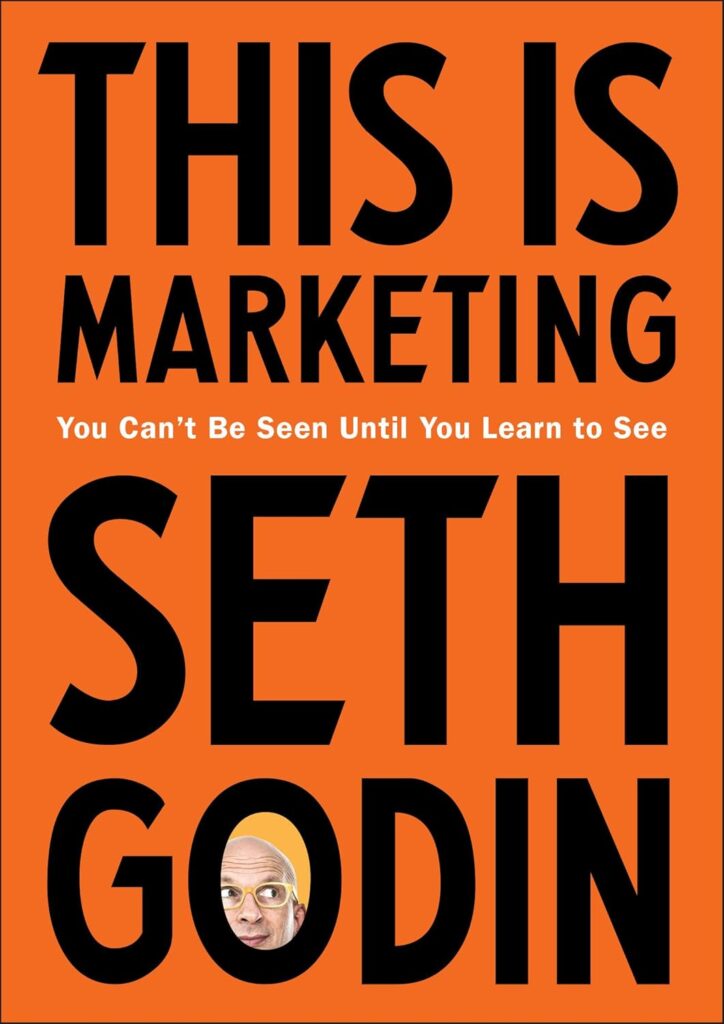Seth Godin’s approach to marketing has fascinated me for years. His book “This is Marketing” offers a fresh perspective on connecting with audiences in our digital age.
I’m excited to dive into the core concepts and show you how they can reshape your marketing strategy.
Just a heads-up: This post contains affiliate links, meaning if you click and make a purchase, I may earn a small commission—at no extra cost to you. I only recommend books and resources I genuinely believe can help you grow as a marketer.
Now, let’s dive into the brilliant marketing insights from Seth Godin!
The Essence of Permission Marketing
Godin’s concept of permission marketing forms the foundation of his philosophy. This approach focuses on earning the right to communicate with potential customers as opposed to interrupting them with unwanted messages.
Permission marketing involves:
- Offering valuable content upfront
- Building trust gradually
- Deepening relationships over time
For example, a software company might create a free e-book on productivity tips. They offer this valuable resource in exchange for an email address.
This initial exchange sets the stage for future interactions, all based on the customer’s consent.
By providing value first, businesses can establish a positive relationship with their audience. This goodwill makes people more receptive to future marketing messages and offers.
Embracing the Minimum Viable Audience
One of Godin’s most powerful ideas is the concept of the minimum viable audience (MVA). He argues that trying to appeal to everyone often results in mediocrity.
Instead, he advocates for focusing on a small, specific group of people who are most likely to appreciate and benefit from what you offer.
This targeted approach allows you to:
- Craft more effective messages
- Build stronger relationships
- Create products that truly resonate
Consider the success of niche products like artisanal, small-batch hot sauces. By catering to a specific group of hot sauce enthusiasts, these brands can create unique flavors and build a loyal following.
This approach contrasts sharply with trying to compete against mass-market brands for a general audience.
Identifying your MVA needs deep research and understanding of your potential customers. It involves looking beyond demographics to understand their values, beliefs, and aspirations.
Once you’ve identified this core group, you can tailor every aspect of your marketing to speak directly to them.
The Power of Storytelling in Marketing
Godin emphasizes that effective marketing revolves around telling authentic stories that resonate with your audience. Marketing should invite people into a narrative where your product or service plays a meaningful role.
Crafting Your Brand Story
To create a compelling brand story:
- Identify your core values and mission
- Understand your audience’s desires and pain points
- Show how your offering aligns with their worldview
- Use consistent messaging across all touchpoints
TOMS Shoes built it’s brand around the story of social impact. Their “One for One” model, where they donate a pair of shoes for every pair purchased, became central to their marketing narrative.
This story resonated with consumers who wanted their purchases to make a positive impact on the world.
Your brand story should be authentic, consistent, and emotionally engaging. It should clearly communicate why your brand exists and how it makes a difference in people’s lives.
Emotional Labor and Empathy in Marketing
Godin introduces the concept of emotional labor in marketing – the work of genuinely connecting with and understanding your audience. This involves:
- Listening actively to your customers
- Anticipating their needs and concerns
- Crafting messages that resonate on an emotional level
Patagonia’s commitment to environmental causes exemplifies this approach. By aligning their marketing with values their audience cares about, they create a deeper, more meaningful connection.
This alignment goes beyond just selling outdoor gear – it positions Patagonia as a partner in protecting the environment their customers love.
Emotional labor in marketing needs a genuine commitment to understanding and serving your audience. It involves creating marketing that feels personal and relevant, as opposed to generic and interruptive.
Overcoming the Challenge of Change
One of the most insightful aspects of “This is Marketing” is Godin’s exploration of how marketing often involves helping people overcome their resistance to change.
The Status Quo Bias
People naturally resist change, even when it’s in their best interest. Effective marketing addresses this by:
- Acknowledging the comfort of the current situation
- Highlighting the cost of not changing
- Painting a vivid picture of the benefits of change
When marketing a new productivity app, you might start by recognizing the familiarity of current methods. Then, illustrate how much time and stress could be saved with the new solution.
This approach respects the audience’s current habits while gently encouraging them to consider a better alternative.
Creating Tension
Godin argues that good marketing creates a kind of tension – a gap between where people are and where they want to be. Your product or service then becomes the bridge to cross that gap.
To create this tension:
- Identify aspirations or pain points your audience has
- Show how your offering addresses these specifically
- Use storytelling to make the benefits tangible and relatable
Fitness brands often use before-and-after stories effectively. They create tension by showing what’s possible, making the viewer want to bridge that gap.
This approach makes use of people’s desires for self-improvement and presents your product as the solution.
The Ethics of Modern Marketing
A crucial aspect of Godin’s philosophy is the emphasis on ethical marketing practices. He argues that sustainable, effective marketing inherently focuses on creating genuine value.
Building Trust in a Skeptical World
In an era of fake news and information overload, building trust is more critical – and challenging – than ever. To build trust:
- Be transparent about your processes and policies
- Admit mistakes and show how you’re addressing them
- Consistently deliver on your promises
Companies like Buffer have built strong reputations by being radically transparent about their operations, including publishing employee salaries. This level of openness builds trust and credibility with their audience.
Ethical marketing practices build trust and create long-term customer loyalty. When customers feel that a brand is honest and has their best interests at heart, they’re more likely to become repeat buyers and brand advocates.
Curious to explore more on ethical marketing? Seth Godin’s insights offer plenty to think about.
The Long Game of Brand Building
Godin emphasizes that effective marketing focuses on playing the long game. Building a brand that people trust and want to engage with over time needs:
- Consistently delivering value beyond just your product
- Engaging with your community in meaningful ways
- Evolving your offerings based on customer feedback
REI has built a strong brand over time by not just selling outdoor gear, but by fostering a community of outdoor enthusiasts through classes, events, and content. This approach has created a loyal customer base that sees REI as more than just a retailer, but as a partner in their outdoor adventures.
Long-term brand building needs patience and consistency. It involves creating a relationship with your audience that goes beyond transactional interactions.
Practical Implementation
Now that we’ve explored the key concepts, let’s look at how to put these ideas into practice.
Step 1: Define Your Minimum Viable Audience
Start by identifying the specific group most likely to benefit from your offering. Research their needs, desires, and pain points in depth.
Craft your messaging to speak directly to this group.
For example, if you’re selling organic baby food, your MVA might be health-conscious, first-time parents in urban areas. Understanding their specific concerns about nutrition, convenience, and environmental impact will shape your entire marketing approach.
Step 2: Develop Your Brand Story
Clarify your brand’s mission and values. Identify how your offering aligns with your audience’s worldview.
Create a narrative that showcases this alignment.
Your brand story should answer questions like:
- Why does your brand exist?
- What problem are you solving?
- How does your approach differ from others?
- What values drive your decisions?
Step 3: Create Value-First Marketing Content
Develop content that provides genuine value to your audience. Use this content to build trust and earn permission for further communication.
Gradually introduce your products or services as solutions to their problems.
This might involve creating:
- Educational blog posts
- Helpful how-to videos
- Free tools or resources
- Informative podcasts or webinars
The key is to focus on providing value first, before asking for anything in return.
Step 4: Foster Community and Engagement
Create platforms for your audience to connect with each other. Engage in two-way communication, listening as much as you speak.
Continuously adapt based on community feedback.
This could involve:
- Creating social media groups
- Hosting events (virtual or in-person)
- Encouraging user-generated content
- Responding promptly to customer feedback
Building a community around your brand creates a sense of belonging and loyalty among your customers.
Step 5: Measure and Iterate
Define metrics that align with your long-term brand-building goals. Regularly assess the effectiveness of your marketing efforts.
Be willing to pivot and experiment based on what you learn.
Some metrics to consider:
- Engagement rates on content
- Email list growth and open rates
- Customer lifetime value
- Net Promoter Score
Remember, these metrics should reflect your long-term goals, not just short-term sales.
Common Pitfalls to Avoid
- Trying to appeal to everyone instead of focusing on your core audience
- Prioritizing short-term sales over long-term brand building
- Neglecting the emotional aspects of marketing in favor of pure logic
- Failing to create a consistent brand story across all touchpoints
- Ignoring customer feedback or failing to adapt to changing needs
Adapting to Different Scenarios
Godin’s principles can be applied across various industries and business models, but they may need to be adapted. Here are some considerations:
B2B Marketing
In B2B marketing, focus on building relationships with key decision-makers. Provide valuable industry insights and thought leadership.
Emphasize the long-term value and ROI of your offerings.
For example, a software company selling enterprise solutions might create in-depth white papers on industry trends, host webinars with thought leaders, and provide detailed case studies showing the long-term impact of their solutions.
E-commerce
In e-commerce, use storytelling to create emotional connections with products. Leverage user-generated content to build trust and community.
Focus on post-purchase experience to foster loyalty and repeat business.
An online clothing retailer might share stories about the artisans who make their products, encourage customers to share photos wearing the clothes, and create a loyalty program that rewards repeat purchases.
Service-Based Businesses
For service-based businesses, showcase the transformation your services provide. Use case studies and testimonials to illustrate value.
Create content that educates and empowers your audience.
A financial advisor might create a series of educational videos on personal finance, share success stories of clients who’ve achieved their financial goals, and offer free initial consultations to show their expertise.
Exercises to Reinforce Learning
Identify Your MVA
Write a detailed description of your minimum viable audience. What are their specific needs, desires, and pain points?
Consider factors like:
- Demographics
- Psychographics
- Behaviors
- Values and beliefs
- Challenges they face
The more specific you can be, the more effectively you can tailor your marketing.
Craft Your Story
Develop a brand story that aligns your mission with your audience’s worldview. How does your offering fit into their narrative?
Consider:
- Your brand’s origin story
- The problem you’re solving
- Your unique approach
- The transformation you provide
Remember, a good brand story is authentic, relatable, and emotionally engaging.
Value-First Content
Create three pieces of content that provide value to your audience without directly promoting your product or service. This could be:
- An informative blog post
- A helpful video tutorial
- A free downloadable resource
Focus on addressing your audience’s needs and pain points, establishing your expertise without a hard sell.
Empathy Mapping
Conduct an empathy mapping exercise for your target audience. What are they thinking, feeling, seeing, and hearing?
Consider:
- Their daily experiences
- Their frustrations and joys
- The messages they receive from other brands
- The influences in their lives
This exercise helps you step into your audience’s shoes and understand their perspective more deeply.
Permission Marketing Plan
Outline a strategy for earning and maintaining permission to communicate with your audience. What value will you offer at each stage?
Consider:
- Initial value offering (e.g., free content)
- Follow-up communications
- Gradual introduction of products/services
- Ongoing value provision
Remember, permission marketing is about building a relationship over time, not pushing for immediate sales. Want to dive deeper into crafting a thoughtful Permission Marketing strategy?
Frequently Asked Questions
What is Seth Godin’s approach to marketing?
Seth Godin advocates for a customer-centric approach to marketing that focuses on building trust, providing value, and creating meaningful connections with a specific audience.
How does permission marketing differ from traditional marketing?
Permission marketing involves earning the right to communicate with potential customers by providing value upfront, as opposed to interrupting them with unsolicited messages.
What is a minimum viable audience?
A minimum viable audience is the smallest group of people who can sustain your business. It’s about focusing on a specific niche as opposed to trying to appeal to everyone.
How can storytelling improve marketing efforts?
Storytelling in marketing helps create emotional connections with your audience, making your brand more memorable and relatable. It helps communicate your values and mission effectively.
What role does empathy play in marketing?
Empathy in marketing involves understanding and addressing your audience’s needs, desires, and pain points. It helps create more relevant and resonant marketing messages.
How can businesses build trust through marketing?
Businesses can build trust through transparency, consistently delivering on promises, providing genuine value, and engaging in honest, two-way communication with their audience.
What is the importance of long-term brand building?
Long-term brand building creates lasting customer relationships, fosters loyalty, and can lead to sustainable business growth. It focuses on creating value beyond just selling products.
How can small businesses apply Godin’s marketing principles?
Small businesses can apply Godin’s principles by focusing on a niche audience, creating valuable content, building community, and prioritizing long-term relationships over short-term sales.
What are some common mistakes in applying these marketing concepts?
Common mistakes include trying to appeal to too broad an audience, prioritizing short-term sales over long-term relationships, and failing to provide consistent value to customers.
How often should a business review and adjust it’s marketing strategy?
Businesses should regularly review their marketing strategy, ideally quarterly, but be prepared to make smaller adjustments more often based on feedback and results.
Key Takeaways
- Focus on a minimum viable audience as opposed to trying to appeal to everyone.
- Create authentic stories that align your brand with your audience’s worldview.
- Prioritize building trust and earning permission over interruption-based marketing.
- Recognize and address the emotional aspects of decision-making in your marketing.
- View marketing as a long-term process of building relationships and delivering value.





